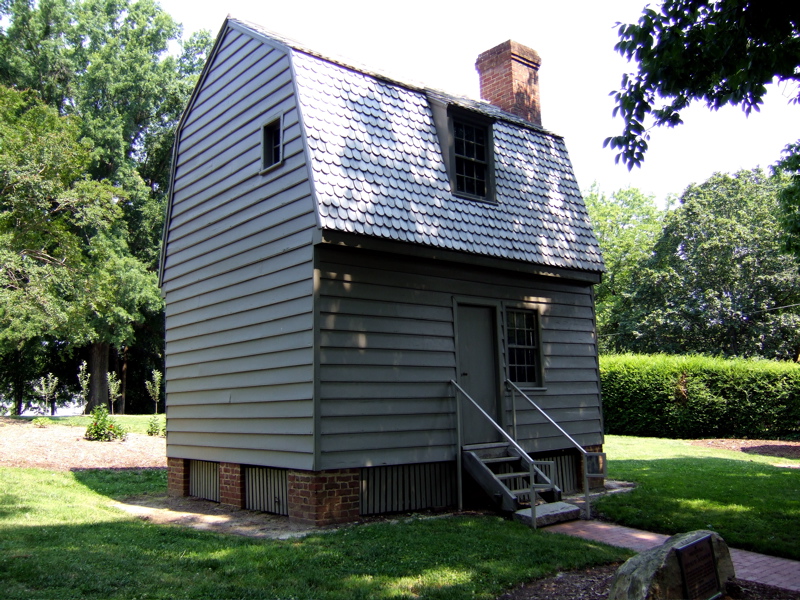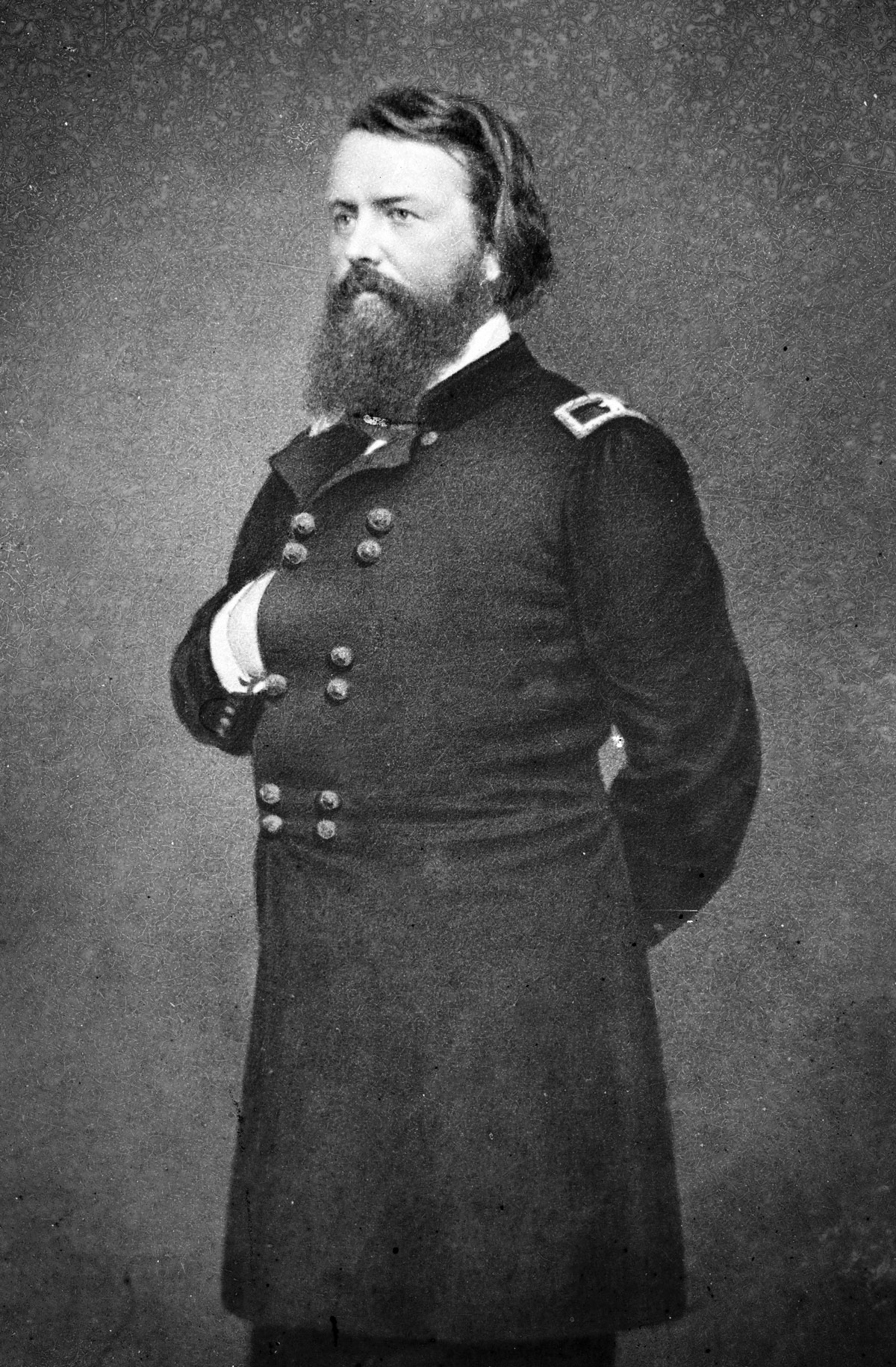|
Napoleon Bonaparte Buford
Napoleon Bonaparte Buford (January 13, 1807 – March 28, 1883) was an American soldier, Union general in the American Civil War, and railroad executive. He was the half-brother of the famous Gettysburg hero, John Buford, but never attained his sibling's military distinction. Early life and education Buford was the son of John and Nancy Hickman Buford. He was born in Woodford County, Kentucky on his family's plantation, "Rose Hill." At the time of his birth his namesake, Napoleon Bonaparte, Emperor of the French, was at the height of his power. Buford graduated from West Point in 1827 and served for eight years in the artillery and in 1835 resigned from the service to become an engineer. He thereafter engaged in iron manufacturing and banking at Rock Island, Illinois and became president of the Rock Island and Peoria Railroad, which went bankrupt when major Southern bonds were defaulted with the start of the Civil War. Career In the U.S. Civil War, he first served as colonel o ... [...More Info...] [...Related Items...] OR: [Wikipedia] [Google] [Baidu] |
Woodford County, Kentucky
Woodford County is a county located in the U.S. state of Kentucky. As of the 2020 census, the population was 26,871. Its county seat is Versailles. The area was home to Pisgah Academy. Woodford County is part of the Lexington-Fayette, KY Metropolitan Statistical Area. It is located in the heart of the Bluegrass region of Kentucky. History The county was formed from a part of Fayette County, Virginia in 1788. It was named for William Woodford, an American Revolutionary War general from Virginia who died while a prisoner of war in 1780. It was the last of the original nine counties established that formed the Commonwealth of Kentucky in 1792. Scott County was formed from part of the county in 1792. Franklin County took another part of the county in 1794. Queen Elizabeth II stayed in Woodford County at Lane's End Farm in May 2007. She also attended the Kentucky Derby in Louisville. Pisgah Academy Pisgah Academy was a school in Woodford County. It was established by Col. Alex ... [...More Info...] [...Related Items...] OR: [Wikipedia] [Google] [Baidu] |
Napoleon Bonaparte
Napoleon Bonaparte ; it, Napoleone Bonaparte, ; co, Napulione Buonaparte. (born Napoleone Buonaparte; 15 August 1769 – 5 May 1821), later known by his regnal name Napoleon I, was a French military commander and political leader who rose to prominence during the French Revolution and led Military career of Napoleon Bonaparte, successful campaigns during the French Revolutionary Wars, Revolutionary Wars. He was the ''de facto'' leader of the First French Republic, French Republic as First Consul from 1799 to 1804, then Emperor of the French from 1804 until 1814 and again in Hundred Days, 1815. Napoleon's political and cultural legacy endures to this day, as a highly celebrated and controversial leader. He initiated many liberal reforms that have persisted in society, and is considered one of the greatest military commanders in history. His wars and campaigns are studied by militaries all over the world. Between three and six million civilians and soldiers Napoleonic Wa ... [...More Info...] [...Related Items...] OR: [Wikipedia] [Google] [Baidu] |
Andrew Johnson
Andrew Johnson (December 29, 1808July 31, 1875) was the 17th president of the United States, serving from 1865 to 1869. He assumed the presidency as he was vice president at the time of the assassination of Abraham Lincoln. Johnson was a Democrat who ran with Lincoln on the National Union ticket, coming to office as the Civil War concluded. He favored quick restoration of the seceded states to the Union without protection for the newly freed people who were formerly enslaved. This led to conflict with the Republican-dominated Congress, culminating in his impeachment by the House of Representatives in 1868. He was acquitted in the Senate by one vote. Johnson was born into poverty and never attended school. He was apprenticed as a tailor and worked in several frontier towns before settling in Greeneville, Tennessee. He served as alderman and mayor there before being elected to the Tennessee House of Representatives in 1835. After briefly serving in the Tennessee Senate, J ... [...More Info...] [...Related Items...] OR: [Wikipedia] [Google] [Baidu] |
Fitz John Porter
Fitz John Porter (August 31, 1822 – May 21, 1901) (sometimes written FitzJohn Porter or Fitz-John Porter) was a career United States Army officer and a Union general during the American Civil War. He is most known for his performance at the Second Battle of Bull Run and his subsequent court martial. Although Porter served well in the early battles of the Civil War, his military career was ruined by the controversial trial, which was called by his political rivals. After the war, he worked for almost 25 years to restore his tarnished reputation and was finally restored to the army's roll. Early life and education Porter was born on August 31, 1822 in Portsmouth, New Hampshire, the son of Captain John Porter and Eliza Chauncy Clark. He came from a family prominent in American naval service; his cousins were William D. Porter, David Dixon Porter, and David G. Farragut. Porter's father was an alcoholic who had been reassigned to land duty. Porter's childhood was chaotic because of ... [...More Info...] [...Related Items...] OR: [Wikipedia] [Google] [Baidu] |
Court-martial Of Fitz John Porter
The court-martial of Fitz John Porter (November 25, 1862January 22, 1863) was a major event of the American Civil War. Major General Fitz John Porter was found guilty of disobeying a lawful order, and misconduct in front of the enemy and removed from command based on internal political machinations of the Union Army. The court-martial was later found to be unjust and overturned, and Porter was reinstated in the United States Army. Background Porter was a career army officer from a family of famous naval officers, including his cousins David Farragut and David Dixon Porter, the first four-star admirals in the United States Navy. He graduated from West Point in 1845, eighth in his class, and served with great distinction as an artillery officer in the Mexican War. After the war, Porter served in various posts, including a stint as an instructor of artillery at West Point, where he became good friends with both George B. McClellan and William B. Franklin and, eventually, post adjutan ... [...More Info...] [...Related Items...] OR: [Wikipedia] [Google] [Baidu] |
Second Battle Of Corinth
The second Battle of Corinth (which, in the context of the American Civil War, is usually referred to as the Battle of Corinth, to differentiate it from the siege of Corinth earlier the same year) was fought October 3–4, 1862, in Corinth, Mississippi. For the second time in the Iuka-Corinth Campaign, Union Maj. Gen. William Rosecrans defeated a Confederate army, this time one under Maj. Gen. Earl Van Dorn. After the Battle of Iuka, Maj. Gen. Sterling Price marched his army to meet with Van Dorn's. The combined force, known as the Army of West Tennessee, was put under the command of the more senior Van Dorn. The army moved in the direction of Corinth, a critical rail junction in northern Mississippi, hoping to disrupt Union lines of communications and then sweep into Middle Tennessee. The fighting began on October 3 as the Confederates pushed the U.S. Army from the rifle pits originally constructed by the Confederates for the siege of Corinth. The Confederates exploited a gap ... [...More Info...] [...Related Items...] OR: [Wikipedia] [Google] [Baidu] |
Siege Of Corinth
The siege of Corinth (also known as the first Battle of Corinth) was an American Civil War engagement lasting from April 29 to May 30, 1862, in Corinth, Mississippi. A collection of Union forces under the overall command of Major General Henry Halleck engaged in a month-long siege of the city, whose Confederate occupants were commanded by General P.G.T. Beauregard. The siege resulted in the capture of the town by Federal forces. The town was a strategic point at the junction of two vital railroad lines, the Mobile and Ohio Railroad and the Memphis and Charleston Railroad. Former Confederate Secretary of War LeRoy Pope Walker called this intersection "the vertebrae of the Confederacy". General Halleck argued: "Richmond and Corinth are now the great strategic points of the war, and our success at these points should be insured at all hazards". Another reason for the town's importance was that, if captured by Union forces, it would threaten the security of Chattanooga, Tennessee, a ... [...More Info...] [...Related Items...] OR: [Wikipedia] [Google] [Baidu] |
Abraham Lincoln
Abraham Lincoln ( ; February 12, 1809 – April 15, 1865) was an American lawyer, politician, and statesman who served as the 16th president of the United States from 1861 until his assassination in 1865. Lincoln led the nation through the American Civil War and succeeded in preserving the Union, abolishing slavery, bolstering the federal government, and modernizing the U.S. economy. Lincoln was born into poverty in a log cabin in Kentucky and was raised on the frontier, primarily in Indiana. He was self-educated and became a lawyer, Whig Party leader, Illinois state legislator, and U.S. Congressman from Illinois. In 1849, he returned to his successful law practice in central Illinois. In 1854, he was angered by the Kansas–Nebraska Act, which opened the territories to slavery, and he re-entered politics. He soon became a leader of the new Republican Party. He reached a national audience in the 1858 Senate campaign debates against Stephen A. Douglas. ... [...More Info...] [...Related Items...] OR: [Wikipedia] [Google] [Baidu] |
President Of The United States
The president of the United States (POTUS) is the head of state and head of government of the United States of America. The president directs the executive branch of the federal government and is the commander-in-chief of the United States Armed Forces. The power of the presidency has grown substantially since the first president, George Washington, took office in 1789. While presidential power has ebbed and flowed over time, the presidency has played an increasingly strong role in American political life since the beginning of the 20th century, with a notable expansion during the presidency of Franklin D. Roosevelt. In contemporary times, the president is also looked upon as one of the world's most powerful political figures as the leader of the only remaining global superpower. As the leader of the nation with the largest economy by nominal GDP, the president possesses significant domestic and international hard and soft power. Article II of the Constitution establ ... [...More Info...] [...Related Items...] OR: [Wikipedia] [Google] [Baidu] |
Western Flotilla
The Mississippi River Squadron was the Union brown-water naval squadron that operated on the western rivers during the American Civil War. It was initially created as a part of the Union Army, although it was commanded by naval officers, and was then known as the Western Gunboat Flotilla and sometimes as the Mississippi Flotilla. It received its final designation when it was transferred to the Union Navy at the beginning of October 1862. History American Civil War The squadron was created on May 16, 1861, and was controlled by the Union Army until September 30, 1862. John Rodgers was the first commander of the squadron and was responsible for the construction and organization of the fleet. Flag Officer Andrew H. Foote relieved Rodgers and encouraged the army commander in the west, Major General Henry W. Halleck, to authorize an expedition down the Tennessee River against Fort Henry. Operating in conjunction with Ulysses S. Grant's Army of the District of Cairo, Foote subdue ... [...More Info...] [...Related Items...] OR: [Wikipedia] [Google] [Baidu] |
Battle Of Island Number Ten
The Battle of Island Number Ten was an engagement at the New Madrid or Kentucky Bend on the Mississippi River during the American Civil War, lasting from February 28 to April 8, 1862. Island Number Ten, a small island at the base of a tight double turn in the river, was held by the Confederates from the early days of the war. It was an excellent site to impede Union efforts to invade the South by the river, as ships had to approach the island bows on and then slow to make the turns. For the defenders, however, it had an innate weakness in that it depended on a single road for supplies and reinforcements. If an enemy force managed to cut that road, the garrison would be isolated and eventually be forced to surrender. Union forces began the siege in March 1862, shortly after the Confederate Army abandoned their position at Columbus, Kentucky. The Union Army of the Mississippi under Brigadier General John Pope made the first probes, coming overland through Missouri and occupyi ... [...More Info...] [...Related Items...] OR: [Wikipedia] [Google] [Baidu] |
Army Of The Mississippi
Army of the Mississippi was the name given to two Union armies that operated around the Mississippi River, both with short existences, during the American Civil War. History 1862 The first army was created on February 23, 1862, with Maj. Gen. John Pope in command. At its creation, the army consisted of 2 divisions of infantry for service along the Mississippi River. When General Pope began to move against New Madrid, Missouri, the army was expanded with units from neighboring military districts. The army now totaled 5 divisions commanded respectively by David S. Stanley, Schuyler Hamilton, John M. Palmer, Eleazar A. Paine and Joseph B. Plummer. Gordon Granger commanded the Cavalry Division of two regiments and Napoleon B. Buford commanded the "Flotilla Brigade". In this capacity the Army fought at the Battle of Island Number Ten. After the capture of Island No. Ten, the army's divisions were consolidated into 3 divisions and became the "Left Wing" of Maj. Gen. Henry ... [...More Info...] [...Related Items...] OR: [Wikipedia] [Google] [Baidu] |









